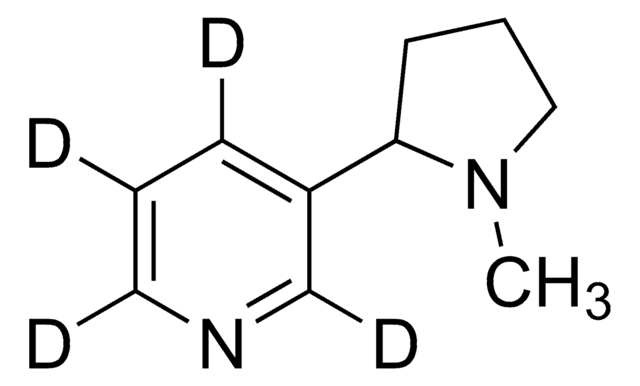75281
N-Nitrosoanatabine
analytical standard
About This Item
Productos recomendados
grado
analytical standard
Nivel de calidad
Análisis
≥97.0% (HPLC)
caducidad
limited shelf life, expiry date on the label
técnicas
HPLC: suitable
gas chromatography (GC): suitable
solid phase extraction (SPE): suitable
aplicaciones
cleaning products
cosmetics
food and beverages
personal care
formato
neat
temp. de almacenamiento
2-8°C
cadena SMILES
O=NN1CC=CCC1c2cccnc2
InChI
1S/C10H11N3O/c14-12-13-7-2-1-5-10(13)9-4-3-6-11-8-9/h1-4,6,8,10H,5,7H2
Clave InChI
ZJOFAFWTOKDIFH-UHFFFAOYSA-N
Descripción general
Aplicación
Palabra de señalización
Danger
Frases de peligro
Consejos de prudencia
Clasificaciones de peligro
Acute Tox. 3 Oral
Código de clase de almacenamiento
6.1C - Combustible acute toxic Cat.3 / toxic compounds or compounds which causing chronic effects
Clase de riesgo para el agua (WGK)
WGK 3
Punto de inflamabilidad (°F)
Not applicable
Punto de inflamabilidad (°C)
Not applicable
Equipo de protección personal
Eyeshields, Faceshields, Gloves, type ABEK (EN14387) respirator filter
Choose from one of the most recent versions:
¿Ya tiene este producto?
Encuentre la documentación para los productos que ha comprado recientemente en la Biblioteca de documentos.
Nuestro equipo de científicos tiene experiencia en todas las áreas de investigación: Ciencias de la vida, Ciencia de los materiales, Síntesis química, Cromatografía, Analítica y muchas otras.
Póngase en contacto con el Servicio técnico







